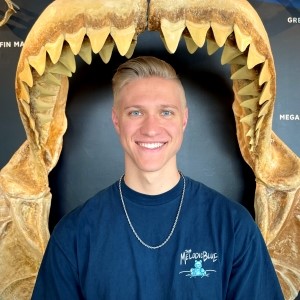
Geology
Surprisingly, finding shark teeth scattered on the shore was not the most exciting part of David Hoppe’s summer. The Senior Geology major with a minor in Biology explains, “it’s cool to find other parts of the body of an organism, like arm bones, vertebrae, or parts of the skull.” Although he’s always been interested in fossils, he recently began collecting in a serious capacity about five years ago. After posting pictures of his collection online, he received an opportunity from the Calvert Marine Museum to work as a field collector.
Located near the Calvert Cliffs—thirty miles of eroded coastline famous for fossils in Maryland—the Calvert Marine Museum has an impressive paleontology exhibit. As a field collector, David donates any significant findings to the museum to be catalogued and researched. Through this position, David met Dr. Stephen Godfrey, the curator of paleontology, and began to formulate plans for his senior thesis.
Early in his junior year, David switched his main area of interest to focus on whales and dolphins. Fascinated by their evolution from fully terrestrial to aquatic mammals, David began to develop a Capstone project that focused on dolphin or whale evolution. As a student in the geology department, David knew he would need an advisor to oversee his project. Based on the connection he already formed with the Calvert Marine Museum, he reached to see if it was a possibility to have Dr. Godfrey serve as his advisor.
Together, Dr. Godfrey and David narrowed the scope of his project to investigate a dolphin skull that the museum collected last October. With help from the Alison MacDonald Doherty Endowment for Geology Student Research, David had the opportunity to travel to and live at Calvert Cliffs for a week. However, once the project got underway, they came to realization that another skull in their data pool represented a different species of dolphin. Even more exciting, the skull was a juvenile. David immediately knew this would be the new focus of his Capstone because it’s “uncommon to find juvenile dolphin skulls.”
With his new subject—“my project is now actually an entirely different species”—David began to analyze the ontogeny of this dolphin species, how the organism changed over the course of its lifetime. He aimed to “compare juvenile specimens to adult specimens and see how the anatomy differs in the two.” Using digital calipers, David took extensive measurements along parts of the skull to collect data and see how the proportions of the bones in the skull changed as the organism developed from a juvenile to adult.
Next came one of the most exciting parts of David’s research experience: a trip to the Smithsonian special collections. David traveled to the Paul E. Garber Facility of the Smithsonian to analog modern bottlenose dolphin skulls and compare them to the skull he was working with. Based on this information, he could not only see the changes from a juvenile to an adult, but he could examine changes between the past and present species. Not to mention, he “got to hold a narwhal tusk.”
His research continued in the Natural History Museum collection in Washington DC. David describes the purpose of this trip with enthusiasm, “they have the only other known skull from this species, and it’s the original type specimen that was used to describe the species way back in the early 1900s.” By accessing the adult skull of the species David is working with, he can best analyze the ontogeny of the organism. To collect data points, he used a handheld 3D scanner to build a model on his computer. He can use this 3D model of the type specimen to compare his measurements of the juvenile specimen.
Now, as the semester continues, David is working to quantify the differences between the skull proportions based on the 3D scan and earlier measurements. While he recognizes the benefit of having a larger data set, he is excited to examine his current “giant Excel spreadsheet.” Since ontogenetic studies of fossil dolphins are rare, based on the uncommon find of a juvenile skull, he is looking into journals or scholastic outlets to publish his research. He also plans to present at the JMU Geology Department showcase and other conferences. It’s exciting to see what David will uncover next.
